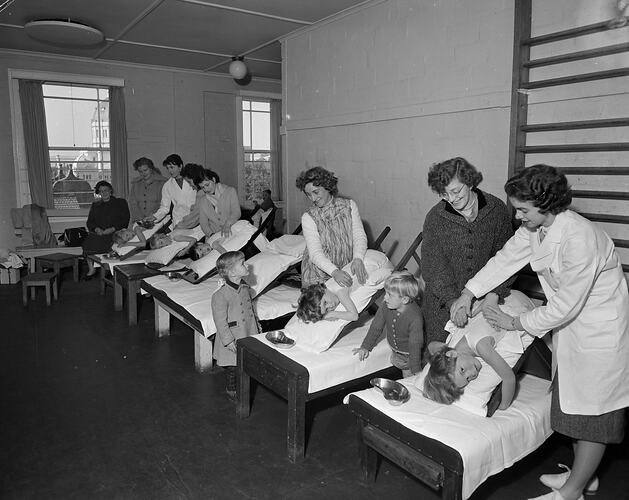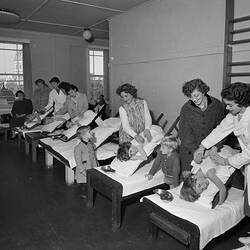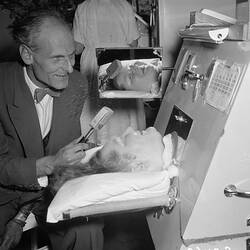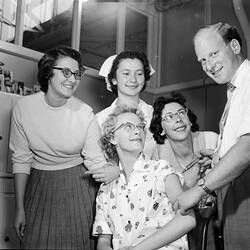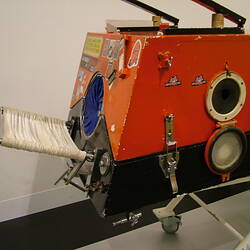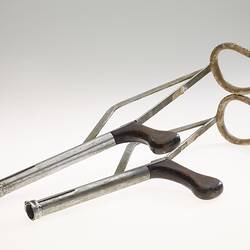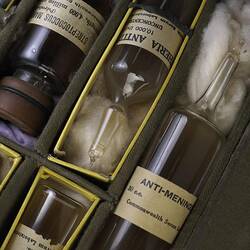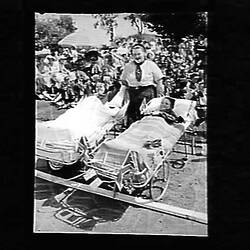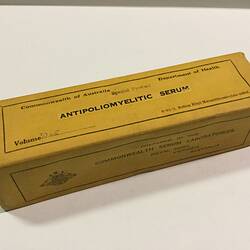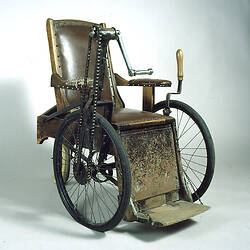Poliomyelitis (polio), also known as infantile paralysis or Heine-Medin disease, is a highly infectious viral disease caused by a human enterovirus of the Picornaviridae family. It most often effects young children but can also be contracted by older children and adults. It enters through the mouth, usually through direct contact with fecal material or secretions from an infected person, but can also be transmitted through contaminated food and water, including swimming pools. In most cases it causes no symptoms but can still be spread by asymptomatic people. It can invade the nervous system through the intestine, and in about 10% of cases results in fever, vomiting, stiffness in the neck and pain in the limbs. In severe cases - less than 1% - the virus destroys nerve cells (motor neurons) which activate skeletal muscles, leading to irreversible paralysis, usually of the legs. Of these, 5-10% die due to paralysis of the breathing muscles. Survivors can also experience post-polio syndrome (PPS) in later life, including motor dysfunction, fatigue and pain.
There is no cure for polio. Treatments such as heat, physical therapies and muscle relaxant drugs aim to reduce symptoms. Breathing aids such as the 'iron lung', in which the whole body was enclosed except the head, supported patients with breathing difficulties, sometimes for months or years (it is now largely obsolete, with alternative therapies available).
Polio was one of the most debilitating infectious diseases of the 20th century, but had been circulating in human populations in previous centuries. German orthopedist Jocob von Heine recognized polio as a disease distinct from other forms of paralysis in 1840. Outbreaks occurred in Europe and the United States in the mid-19th century, reaching pandemic proportions in the USA in 1894.
In Victoria, infantile paralysis (as it was then called) was increasingly reported in newspapers from the 1870s. The lack of effective treatments was reflected in the use of 'miracle' cures such as that of the 'great Australian healer', Milner Stephen, who claimed to have cured paralysis in a mass meeting in Russell Street, Melbourne, in August 1892. 'Electrizations' were offered for infantile paralysis in 1878; and in 1879 Miss Elphinstone Dick established a Ladies' Gymnasium in Collins Street which claimed to help cases. In 1896 'The Doctor' in the Herald newspaper advised a correspondent in Wangaratta that her little girl was probably suffering infantile paralysis and would 'obtain the most benefit by a course of systematic massage, combined with galvanism and general constitutional tonic treatment'.
In 1905 Swedish Otto Ivar Wickman recognized that polio was highly contagious, and in 1908 Austrians Karl Landsteiner and Erwin Popper identified the etiologic agent of polio. Increasing outbreaks were seen in many countries, including Australia, where polio became a notifiable disease in 1922 (and from 1911 in Tasmania). The Argus noted in 1937 that it appeared to erupt every three years in Melbourne - for instance, in 1931, 1934 and 1937. The 1937-38 outbreak was particularly severe in Melbourne, and was also experienced in pockets across Victoria. Schools were closed, and children and prams were banned from public transport. By 1938 the incidence of notified cases peaked at 39.1 per 100,000 population.
From 1904, Fairfield Infectious Diseases Hospital in Melbourne provided isolation and specialized treatments for children and adults suffering from polio and other serious infectious diseases. Treatments for polio, which focused on immobilizing limbs and keeping patients comfortable, improved through better understanding of the virus and its effects. In 1932 former World War I nurse, Australian-born Sister Elizabeth Kenny, began to treat polio patients with hot baths and active movement, discarding braces and calipers. Her methods were largely shunned by the medical profession, but they offered hope and were gradually accepted, particularly in America. Her methods were a forerunner to modern physiotherapy.
The breakthrough in the fight against polio came with the development of vaccines, led by Jonas Salk with a formalin-inactivated vaccine (IPV) in 1953 and Albert Sabin with a live-attenuated vaccine (OPV) in 1956. The Commonwealth Serum Laboratories (CSL) in Melbourne sent Dr Percival Bazeley to work with Salk at the University of Pittsburgh, Pennsylvania in 1952. Salk vaccine trials started in Australia in 1954; Bazeley returned to Melbourne in 1955 and manufacturing the dead-virus vaccine began. As vaccinations were delivered rates of polio in Australia dropped significantly, although herd immunity was not reached quickly enough, and in 1961-62 another polio outbreak occured. In 1966 Sabin's oral vaccine was introduced, further contributing to community safety in Australia.
The Global Polio Eradication Initiative, launched in 1988, resulted in the reduction of polio cases by 99%. Today wild poliovirus is only known in Pakistan and Afghanistan.
References
1878 'Advertising', The Age (Melbourne, Vic. : 1854 - 1954), 5 July, p. 1. , viewed 19 Jun 2020, http://nla.gov.au/nla.news-article199354256.
1879 'MISS DICK'S CYMNASIUM.', The Herald (Melbourne, Vic. : 1861 - 1954), 3 April, p. 3. , viewed 19 Jun 2020, http://nla.gov.au/nla.news-article246225273.
1888 'Advertising', The Age (Melbourne, Vic. : 1854 - 1954), 28 January, p. 11. , viewed 19 Jun 2020, http://nla.gov.au/nla.news-article191204110.
1892 'A Modern Miracle Worker.', The Coburg Leader (Vic. : 1890 - 1913), 10 August, p. 4. , viewed 19 Jun 2020, http://nla.gov.au/nla.news-article66900464.
1896 'OUR DOCTOR.', The Herald (Melbourne, Vic. : 1861 - 1954), 24 September, p. 3. , viewed 19 Jun 2020, http://nla.gov.au/nla.news-article241086307.
1937 'SCHOOLS CLOSED TO 28,000', The Herald (Melbourne, Vic. : 1861 - 1954), 24 July, p. 1. , viewed 22 Jun 2020, http://nla.gov.au/nla.news-article244545339.
1937 'PARALYSIS EPIDEMIC ANALYSED', The Argus (Melbourne, Vic. : 1848 - 1957), 9 September, p. 5. , viewed 19 Jun 2020, http://nla.gov.au/nla.news-article11091971.
1954 'Salk Polio Vaccine Being Tested Here', Warwick Daily News (Qld. : 1919 -1954), 16 December, p. 1. , viewed 26 May 2021, http://nla.gov.au/nla.news-article190462666.
A. Baicus, 2011. 'Poliovirus'. In Liu (ed.), Molecular Detection of Human Viral Pathogens, CRC Press, pp. 75-86.
'Polio vaccine introduced in Australia'. National Museum of Australia, https://www.nma.gov.au/defining-moments/resources/polio-vaccine-introduced-in-australia, accessed 26 May 2021.
H. J. Eggers, 1999. 'Milestones in Early Poliomyelitis Research (1840 to 1949)'. J Virol. 1999 Jun; 73(6): 4533-4535.
R. Hall, 1993. 'Notifiable diseases surveillance, 1917 to 1991'. Commun Dis Intell 1993,17: 226-236.
J. McCalmun, 'Diseases and Epidemics', eMelbourne, http://www.emelbourne.net.au/biogs/EM00473b.htm accessed 18/6/2020.
J. McMeekan, 2018. 'Remembering Australia's Polio Scourge'. University of Melbourne, Pursuit, https://pursuit.unimelb.edu.au/articles/remembering-australia-s-polio-scourge, accessed 18/6/2020.
R. Patrick, 'Kenny, Elizabeth (1880-1952)', Australian Dictionary of Biography, National Centre of Biography, Australian National University, http://adb.anu.edu.au/biography/kenny-elizabeth-6934/text12031, published first in hardcopy 1983, accessed online 19 June 2020.
J.M.S. Pearce, 2005. 'Poliomyelitis (Heine-Medin Disease)'. In Journal of Neurology, Neurosurgery & Psychiatry 2005, 76:128.
S. Li Hi Shing, R. H. Chipika, E. Finegan, D. Murray, O. Hardiman, and P. Bede, 2019.
Polio History Timeline, Polio Australia, https://www.poliohealth.org.au/polio-timeline/, accessed 19/6/2020.
'Poliomyelitis (polio)', World Health Organisation, https://www.who.int/health-topics/poliomyelitis#tab=tab_1, and https://www.who.int/biologicals/areas/vaccines/poliomyelitis/en/, accessed 18/6/2020.
'Post-polio Syndrome: More Than Just a Lower Motor Neuron Disease'. Front Neurol, 2019, 10: 773. doi: 10.3389/fneur.2019.00773.
More Information
-
Keywords
-
Authors
-
Article types
